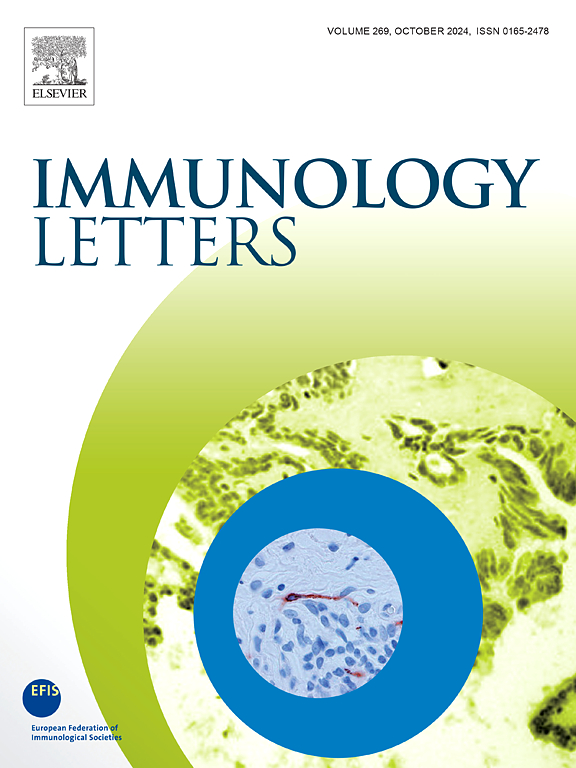Tryptophan metabolism in health and disease- implications for non-communicable diseases
IF 2.8
4区 医学
Q3 IMMUNOLOGY
引用次数: 0
Abstract
Tryptophan, an essential amino acid, is primarily metabolized through four key pathways: the kynurenine pathway, serotonin pathways, indole pathways and interleukin 4-induced gene 1 (IL-4I1) pathways. Dysregulation of tryptophan metabolism is implicated in various non-communicable diseases including psychiatric disorders, inflammatory and autoimmune diseases, as well as metabolic diseases. The dogma in the field is that tryptophan is metabolized via the kynurenine pathway in the liver mainly by indoleamine 2,3-dioxygenase 1/2 (IDO 1/2) and Tryptophan dioxygenase 2 (TDO2) enzymes. However, there is growing evidence demonstrating that IL-4I1 and tryptophanase are also crucial tryptophan catabolizing enzymes resulting in metabolites that activate aryl hydrocarbon receptor (AhR) and modulate immune responses. Tryptophan metabolism is crucial in cellular, tissue and organismal function and its disruption is linked to conditions such as inflammatory bowel disease (IBD), multiple sclerosis (MS), and psychiatric disorders like depression, anxiety and metabolic diseases such as obesity and Type 2 diabetes. It is unclear though whether only specific tryptophan pathways are associated with disease or there is a level of redundancy. Some key metabolites from tryptophan catabolism can come from multiple pathways, with opposing or converging effects on cellular functions. This review will explore the critical role of tryptophan metabolism in health and diseases, focusing on its implications in non-communicable diseases. Importantly, this review will focus on recent developments in tryptophan metabolism and strengthen the argument for a revised schematic tryptophan catabolic pathway.
健康和疾病中的色氨酸代谢-对非传染性疾病的影响。
色氨酸是一种必需氨基酸,主要通过四个关键途径代谢:犬尿氨酸途径、血清素途径、吲哚途径和白细胞介素4诱导基因1 (IL-4I1)途径。色氨酸代谢失调与各种非传染性疾病有关,包括精神疾病、炎症和自身免疫性疾病以及代谢性疾病。该领域的教条是,色氨酸在肝脏中主要通过吲哚胺2,3-双加氧酶1/2 (IDO 1/2)和色氨酸双加氧酶2 (TDO2)酶代谢犬尿氨酸途径。然而,越来越多的证据表明,IL-4I1和色氨酸酶也是关键的色氨酸分解代谢酶,其代谢产物激活芳烃受体(AhR)并调节免疫反应。色氨酸代谢对细胞、组织和机体功能至关重要,它的破坏与炎症性肠病(IBD)、多发性硬化症(MS)、抑郁症、焦虑症等精神疾病以及肥胖和2型糖尿病等代谢性疾病有关。目前尚不清楚是否只有特定的色氨酸途径与疾病有关,还是存在一定程度的冗余。色氨酸分解代谢的一些关键代谢物可以通过多种途径产生,对细胞功能具有相反或趋同的作用。本文将探讨色氨酸代谢在健康和疾病中的关键作用,重点关注其在非传染性疾病中的意义。重要的是,本综述将关注色氨酸代谢的最新进展,并加强对修订后的色氨酸分解代谢途径示意图的论证。
本文章由计算机程序翻译,如有差异,请以英文原文为准。
求助全文
约1分钟内获得全文
求助全文
来源期刊

Immunology letters
医学-免疫学
CiteScore
7.60
自引率
0.00%
发文量
86
审稿时长
44 days
期刊介绍:
Immunology Letters provides a vehicle for the speedy publication of experimental papers, (mini)Reviews and Letters to the Editor addressing all aspects of molecular and cellular immunology. The essential criteria for publication will be clarity, experimental soundness and novelty. Results contradictory to current accepted thinking or ideas divergent from actual dogmas will be considered for publication provided that they are based on solid experimental findings.
Preference will be given to papers of immediate importance to other investigators, either by their experimental data, new ideas or new methodology. Scientific correspondence to the Editor-in-Chief related to the published papers may also be accepted provided that they are short and scientifically relevant to the papers mentioned, in order to provide a continuing forum for discussion.
 求助内容:
求助内容: 应助结果提醒方式:
应助结果提醒方式:


